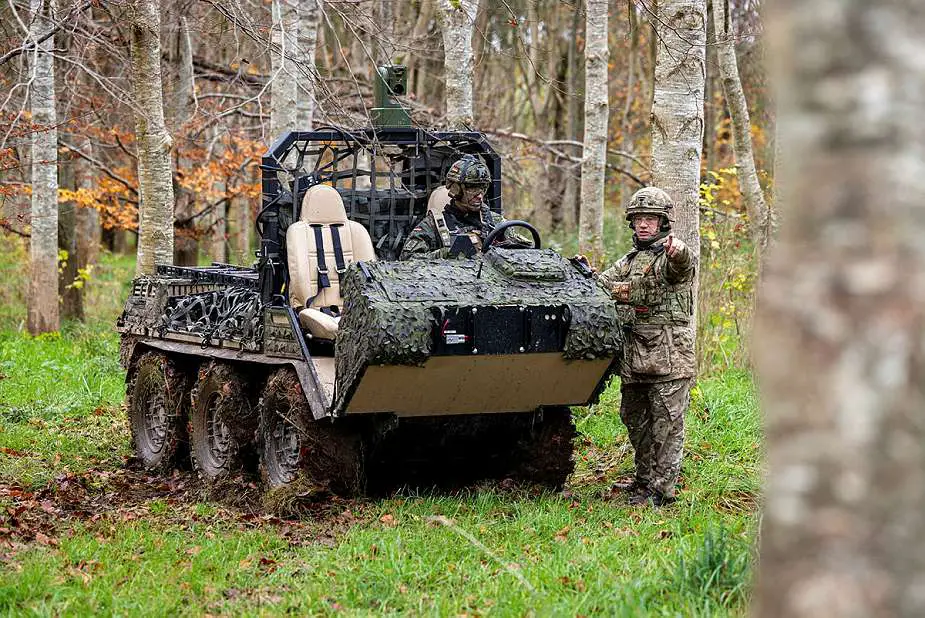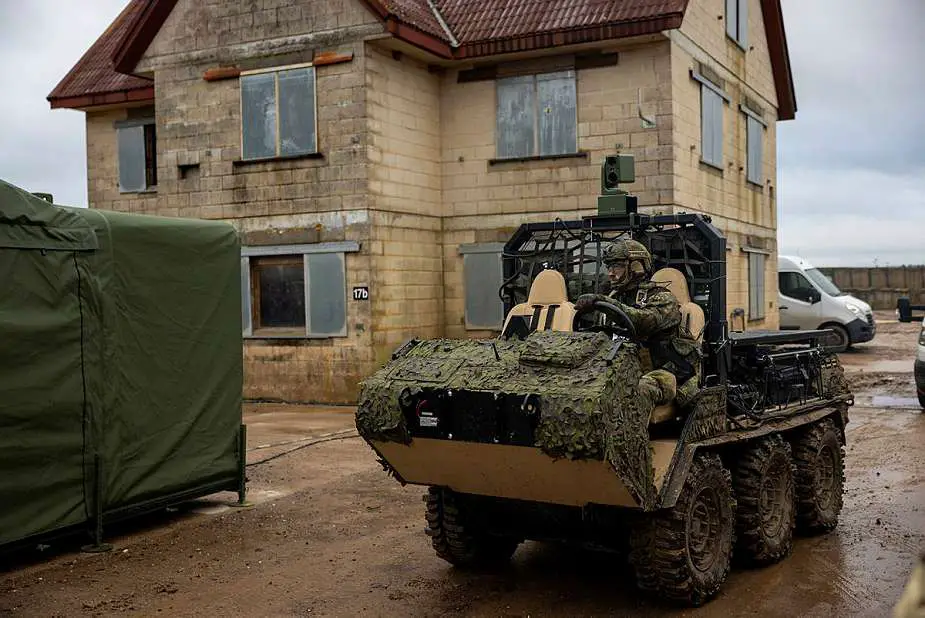Breaking news
British Army Trials Hybrid Amphibious Vehicle HAWC for Modern Warfare.
In November 2023, the British Army, in collaboration with international allies and industry partners, embarked on a major testing exercise for new military technology, including the innovative Hybrid Amphibious Wheeled Carrier (HAWC). This exercise, named 'Blunting Strike,' is part of the broader Army Warfare Experiment (AWE), aiming to adapt the British Army to the changing dynamics of modern warfare.
Follow Army Recognition on Google News at this link

Working alongside each other, British and German soldiers test the HAWC vehicle which can be either driven or remotely piloted. (Picture source UK MoD)
The HAWC, a versatile combat vehicle, can be either driven or remotely piloted, marking a significant leap in military vehicular technology. This month, British and German Service personnel have been actively testing the HAWC at Copehill Down on Salisbury Plain. The vehicle is designed to meet the demanding requirements of deploying soldiers in diverse and challenging environments, reflecting the shifting landscape of contemporary battlefields.
Exercise Blunting Strike has brought together soldiers from the British Army Experimentation and Trials group and their counterparts from the USA, France, Italy, Germany, and Spain. This multinational collaboration underscores the importance of understanding new equipment and developing strategies for integration and cooperation with international forces.
Industry partners play a pivotal role in this exercise, offering innovative solutions to modern military challenges. They work closely with the troops to explore the practical applications of the new equipment and understand its current limitations. This collaboration is crucial for the British Army's objective to accelerate transformation under its 'Future Soldier' initiative, which seeks to harness emerging technologies for future capability development.
AWE is structured in three levels, with the current Level C focusing on user testing and experimentation by soldiers. Previously, Level A involved a 'Dragon’s Den' style scenario where industry providers proposed solutions to specific problems posed by the British Army, such as urban warfare challenges, drone countermeasures, and medical evacuation in built-up areas. Following this, Level B entailed safety testing of the proposed solutions.
The British Army's proactive approach in 'Exercise Blunting Strike' represents a significant stride towards modernizing its capabilities and readiness for future challenges. By working closely with international partners and industry innovators, the Army is positioning itself at the forefront of technological advancement in military operations.

The HAWC vehicle (which can be either driven or remotely piloted) is driven by a German Soldier during the Army Warfare Experiment Ex Blunting Strike in Copehill Down. (Picture UK MoD)
The HIPPO HAWC (Hybrid Amphibious Wheeled Carrier) developed by the American company HIPPO Multipower, is transforming the dynamics of military mobility with their multi-purpose capabilities. These platforms are designed to significantly ease the burden on dismounted soldiers and light forces, while also reducing risk in challenging operational scenarios.
One of the key features of the HIPPO HAWC is its impressive payload capacity. Each can carry a total load of up to 1000 kg, which plays a crucial role in supporting dismounted operations. This substantial capacity enables soldiers to move more efficiently and focus on core activities such as shooting and communicating. Additionally, the modular cargo retention system of these platforms allows for rapid reconfiguration to suit a variety of missions. They can be adapted for tasks ranging from tactical load carriage and resupply to casualty evacuation, weapon carriage, and even specialized roles in surveillance, engineering, communications, and fire & rescue operations.
In terms of mobility, the HIPPO HAWC excels in versatility and accessibility. They are designed to be internally transportable by support helicopters or can be delivered via parachute, making them ideal for airborne and airmobile operations. The electric drive in these vehicles provides instant torque, essential for navigating extreme terrains, which is particularly beneficial in operations in jungle and mountainous environments. When operating on battery power, both platforms maintain extremely low acoustic and thermal signatures, facilitating covert operations like sniper insertion or providing support to advancing troops with minimal detection. Moreover, an integrated diesel generator in these vehicles ensures extended range and endurance, with the capability to cover over 150 kilometers.
Another remarkable aspect of these vehicles is their incorporation of Robotics and Autonomous Systems (RAS). The HAWC is available in both manned and optionally manned/autonomous configurations, offering flexibility based on mission requirements. The use of RAS not only allows for more efficient use of manpower but also significantly enhances soldier safety by enabling operations such as delivering supplies under fire without exposing soldiers to direct danger.
These advancements highlight the HIPPO HAWC as a cutting-edge solution in military logistics and support, offering unparalleled support to modern military operations and significantly enhancing the capabilities of dismounted soldiers and light forces.
Defense News December 2023


























